"Finding the right golf teaching professional is critical if your child is to enjoy the challenges of playing golf and at the same time being guided to keep improving so they can stay and play the game for the rest of their lives." 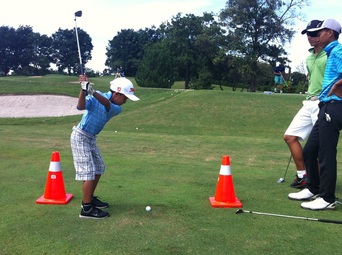 It may seem like an easy task to pick a competent golf teaching professional for your child to be introduced to the game of golf. Maybe they are already playing and want to take their game to the next level? So is getting onto the internet to find the nearest available golf teaching professional and making an appointment to see them a problem solved? Probably not. Finding the right golf teaching professional is critical if your child is to enjoy the challenges of playing golf and at the same time being guided to keep improving so they can stay and play the game for the rest of their lives. 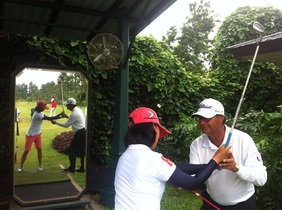 The careful selection of a competent golf instructor will allow your child to build a strong bond and rapport with that professional who can also help to instill important life skills that will be used on and off the golf course. The following 7 questions below and the responses you will receive from them should guide you in your selection of the golf teaching professional that you will entrust your child's ongoing development to.
The response to these 7 questions will allow you to select a golf teaching professional that has the broad range of skills to encourage, motivate, guide and mentor your child. He or she if they have the skills and experience in junior development will help form all the psychological characteristic's required for your child to become a well rounded person. And if this is achieved their golf game follows in the same direction. So ask the 7 questions above, and your selection of the right teaching professional for your child will be made a lot easier. The best of luck with it. David Milne and Lawrie Montague - Pro Tour Golf College Your Success On Tour is Our Business "Your golf success will ultimately be determined by your ability to write lower golf scores on your score card in tournaments. Therefore your practice effort should always be driven towards development of the key golf skills that have the greatest influence on reducing your golf scores in tournaments."  In my last article I shared with you that the starting point of developing your annual golf success plan is to establish your key performance objectives for the season in 6 specific areas and then to lay out your tournament schedule to identify your golf “majors.” In this article I will take it one step forward and show you how to drive your golf skills practice so that you can improve your key golf skills at the most ideal time in your golf season. L = LEVERAGE: The next letter in the P.L.A.N approach is L which stands for leverage. Leverage in its simplest form describes how you can apply a small amount of effort through the use of a lever and fulcrum to move a large obstacle. Golf scores that plateau are obstacles that hinder improvement and leverage as it relates to golf improvement describes small deliberate changes in your golf skill practice combined with a well-planned quantity and quality of practice that leads to large changes in your golf score average over time. Lower golf score = Improve most important golf skills So in this context we are using leverage to influence the practice and development of the key golf skills with the sole objective of building a competitive advantage in your scoring ability. It is the advantage gained by improving key golf skills that will have the greatest impact on lowering your golf score average in tournaments. 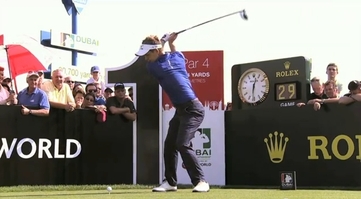 There is only one way you can truly separate the best golfers in the world from all other golfers and it is so simple to understand; your golf score average in tournaments defines you level of success in golf. It’s not hard work on the golf skills you are already very good at, or even perfecting your golf swing technique; it’s working on lowering your golf score average through carefully planned and actioned practice strategies. Your golf success will ultimately be determined by your ability to write lower golf scores on your score card in tournaments. Therefore your practice effort should always be driven towards development of the key golf skills that have the greatest influence on reducing your golf scores in tournaments. These key golf skills are what we call at Pro Tour Golf College your weakest-most-important golf skills and they are the skills that when driven upwards, will drive your golf scores downwards. In our golf success model (below) you can see that I’ve added the periodization frame to the tournament and objectives frame and you can see on the left hand side a number of categories;
GOLF PLAN AND DESIGN STAGE 2 - GOLF TRAINING AND SUB TRAINING PHASES (Micro and Macro Cycles)Training Phases and Sub Phases You will recall that we plan the tournaments that we want to compete in and highlight the ones we want to play our best in? Well, how do we organize our time to ensure that we practice the weakest-most-important golf skills at the right time? We break up our annual plan into training phases where we can concentrate on skill development or fine tuning of golf skills at the most ideal times throughout the golf season. You see training phases need to vary so that you can adapt and improve as a result of the specific demands you place on your golf practice. A periodized golf training plan is divided into a number of unique time periods and each of these periods or phases has specific training goals and training emphasis attached to them. Notice in our model (below) the general training phases and the sub training phases? Basically you go from a preparatory phase where you work on developing your weakest-most-important golf skills, and time the training of this skill set into a competitive phase, and then onto a transition or recovery/restorative phase, (though not necessarily in that order). The sub phases of your general training phases really gets into the specificity of your golf practice. Study the image below to understand the sub-training phases and how you design your practice strategy around your golf tournaments. The key to this is to get your game to a stage where you are confident going into a competition phase. Many elite golfers make the fatal mistake of still working on technical aspects of their golf swing (general preparation phase) when they are in a competitive phase which just pushes your golf score average upwards. Skill Acquisition Specific golf practice strategies are designed to avoid plateauing in performance through the variation in the amount or quantity of golf shots that are hit, and also the level of intensity of the practice effort. Usually when we are in a high volume phase (like when working on improving an aspect of our golf swing technique), the intensity is lower, and when we are in a high intensity phase, (like working on shot-making skills) the volume is lower. 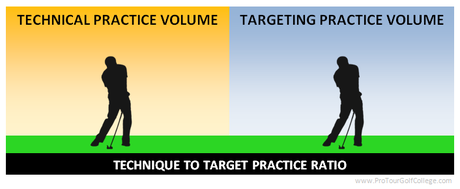 In our program we define the periods we want to improve our students technical skills as T1 skills and the targeting skills as T2 skills. This helps us to determine the quantity of shots to be hit as well as the level of intensity in the different time periods through the year. A good point to remember is that when we are working in a technical phase the volume of repetitions will be higher and the intensity level lower. As we move closer to a competitive phase the volume of repetitions tapers and there is an increase in the amount of targeting skill work done, and the level of intensity also increases. Instead of just hitting golf shots and hoping to play well in tournaments you need to plan the type of practice that you will do based on your needs at the time and the relevance of the practice to driving your golf score average down. The image below describes a microcycle (week of training) and the ratio of volume to intensity in a general preparation phase for a student at Pro Tour Golf College. 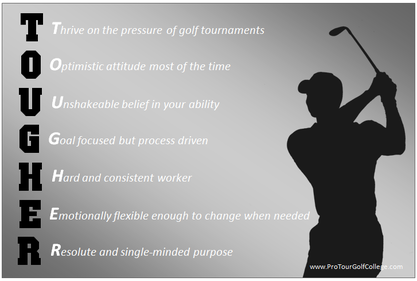 Click on the image to make it larger Click on the image to make it larger Psychological Skills Throughout the training phases you have to work very hard on your mental skills so that you can sustain the work load and intensity requirements to play your best when it matters to you. You should work closely with your coach and if you have one, a mental skills coach to help you to manage your thoughts and emotions leading into golf tournaments. This is an essential part of an elite golfers development and cannot be stressed enough. In your mental plan you will work on imagery practice, self talk strategies and E.Q (Emotional quotient) management techniques, and also relaxation techniques to complement the physical practice and tournament play you are performing throughout the golf season. Micro Cycles, Meso Cycles and Macro Cycles The final part of the periodization frame is the macro, meso and micro cycles. With 52 weeks in the year you need to plan your preparation for tournament play and practice objectives carefully and the training cycles make this much easier to do. In our periodization example from above you can see that we have broken our annual plan into 16 cycles which describes a full macro cycle or year. These cycles influence the volume, intensity, frequency and duration of your practice effort during this time period.
This is a simple example of how you can use training cycles to improve a skill set and enhance your performance. The micro, meso and macro training cycles are an integral part of your annual golf success plan to develop and improve your golf skills and performances. So now you are starting to understand the power of a well thought out and carefully planned approach to your golf season. It might seem a little complicated at first but do take the time to study the model and understand how you can use it to enhance your golf skills and golf course performances.
In the 3rd part of our article series on developing your annual golf success plan next week I'll cover the last 2 parts of our P.L.A.N strategy and show you how to put the final parts of your golf success plan puzzle together. So until then the best of luck with your golf success plan and if you have any questions about it then feel free to drop us a line. Lawrie Montague and David Milne - Pro Tour Golf College Your Success On Tour is Our Business "The question that periodization can help you to answer is what type of practice will be done within each cycle (season) so that it enables you to perform to the best of your current ability when important tournaments take place". We are approaching the end of another year of golf and possibly you are starting to think about next year and what you will do to play better than you did this year. It could be that you want to lower your golf score average so you can achieve goals like winning a club championship, or maybe you are at the stage where you are considering going to tour school because you want to play on a professional golf tour. Whatever your goals are for the New Year one thing is for certain, designing a plan for getting there will help, and designing an annual plan will be better than just having a list of outcomes and it will help you to stay focused and on track. But how do you design an annual plan for golf you might be thinking? To begin with let’s look at the two basic components that will be involved in an annual golf training plan. 1. Time 2. Effort (practice and play) Designing an annual plan is an exercise in time and effort management in simple terms. You are going to invest a certain amount of effort in your game via practice and play to perform to your expectations on the golf course. This ratio of effort requires time both in terms of physical effort and also mental effort. So ideally we need to construct a template that takes into consideration the tournaments we wish to play in over the course of a year and also the type of practice that we will do prior to, during and after a tournament. This practice will be driven by your desire to play to the best of your current ability in the tournaments that you rank as most important to you. 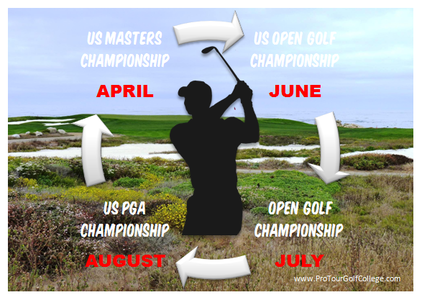 I’m sure that you would agree that Tiger Woods would like to play his best at least four times in a season, in April, June, July and August which is when the major championships are held. Yes he wants to play to the best of his ability in every tournament he enters, but these four tournaments are the most important ones for him. What would your most important tournaments be, these are the ones that you would like to place well in, or indeed win? When we design a plan, like any plan it has elements that help you to determine where you are in the process, and tools to help you measure, monitor and adjust as you need to. No golf plan is set in stone, it needs to be flexible and change, and is a true reflection of golf performance that ebbs and flows, that has high points and low points.  At Pro Tour Golf College we use a simple acronym P.L.A.N to help design and manage the change process within the annual plan. P = PERIODIZATION: Periodization is an organized and efficient planning system for your golf practice effort and your tournament play which encompasses a progressive cycling of several characteristics within your golf training program during specific periods in the golf season. It is a method for regulating your golf stroke and target training to peak at a specified period within your golf season. The real worth of a periodized approach to golf development is to plan when you introduce new skills into your practice, as well as to continue to develop existing golf skills in your game as you progress through your annual plan (which is also called a macrocycle) and to develop those skills so that you reach the stage of automaticity with them at a specific time within the plan. Long-Term Golfer Development A junior golfer of 10 years of age will likely go through 10 to 12 Macrocycles before they turn professional. Within these ten to 12 cycles many tournaments will be played, many skills will be learned, and lots of golf balls will be hit. Look at the following example of what a long term view of a junior golfers score development might look like. This is 12 cycles from the age of 10 years to 22 years. The question that periodization can help you to answer is what type of practice will be done within each cycle (season) so that it enables you to perform to the best of your current ability when important tournaments take place. Specialization might occur for a junior golfer around the age of 13 to 16 years (down from 16 to 19 years last century) and this is where a golfer decides that the sport of golf is what they truly want to excel at. Before this period they are usually just competing in tournaments, practicing modestly and enjoying the game. However when they reach the specialization stage (where they make the decision that this is going to be their career) it becomes a lot more serious. And by serious we mean that the work load increases greatly and expectations of how they perform in tournaments becomes more of a central focus. When you design a long term periodized plan for improvement you can manage your expectations more easily, which just happens to be one of the biggest challenges you constantly face as you continue to improve. The chart above describes what a performance curve might look like over an extended time period for a junior golfer through to senior level. This chart could just as easily be for a rookie tour player (below) who is looking at a long term view of his annual performance targets to help him/her to stay focused and motivated towards continuous improvement. Can you see that this can performance curve can adjust as you develop and improve, and that the actual curve in real terms would be a lot more erratic within each annual cycle? This is where the true value of an annual plan comes into its own. You can design your plan around your tournaments and work out the amount of golf shots (volume) as well as the level of intensity, and you can also determine the types of golf shots you want to improve to lower your scores so you can achieve your tournament goals. So when we look at a macrocycle, the tournaments you play in will obviously fall within the 52 weeks of the calendar year. When we design the first stage of the periodized plan it will look something like the one below. GOLF PLAN AND DESIGN STAGE 1 - OBJECTIVES, TOURNAMENT DATES AND LOCATIONSYou can see that at the top of the plan we list the following Six Performance Objective Categories:
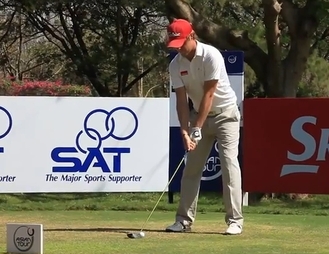 In the example above I’ve identified the state tournaments that John Anderson will play in and also the tournaments that he’d like to peak in (highlighted in yellow), which is to say the tournaments that he wants to play his best in. You could have a combination of state, national and international tournaments that you wish to play in and the beauty of a periodized plan is that you can see your season on one page, and from this vantage point it is a lot easier to decide how you will practice your golf skills to improve your performances on the golf course. Next week we'll go to stage two of designing your annual golf success plan and we will be focusing on golf training phases within the season which is where the periodization starts to help you manage the practice work load and intensity in and around the tournaments you have chosen to play in. Lawrie Montague and David Milne - Pro Tour Golf College Your Success On Tour is Our Business 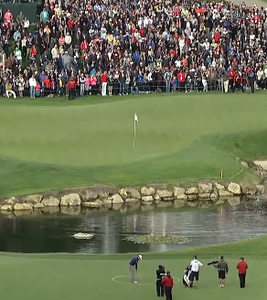 Last Week Zac Johnson holed a 68 yard pitch shot on the 72 hole to tie Tiger Woods and then proceeded to beat him in the playoff at the Northwestern Mutual World Challenge! Winning tournaments with quality approach wedges is nothing new for Zac as he won the 2007 US Masters by laying up on all the par 5's every round and still led the field for par 5 scoring that week with an impressive 11 under. Now when you think about the best golfers who have played the game, Zac Johnson's name I am sure will not pop up in your mind. But when you dig deeper into what Zac has achieved since he turned professional in 1998 it is very impressive indeed. On the USPGA Tour he has won 10 times and accumulated over US $30 million in winnings and ranks 15th on the all time money list. Throughout his career he has been a consistent money making machine. Last year he won over US $4 million ranking 9th, winning once, and had 8 top tens. He played in 24 tournaments and made the cut in twenty of them. 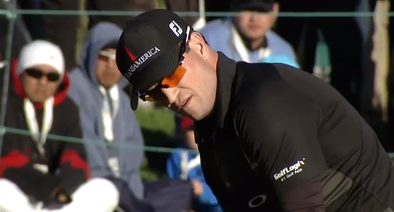 Zac Johnson like many tour golfers found the transition from amateur to professional not all smooth going. He learnt to play professionally by serving his apprenticeship on the mini tours starting on the Prairie Tour for two years winning once in 1998 and finished 3rd on the 1999 money list. He kept improving and was the Player of the Year on the competitive Hooters tour and from there graduated to the Web.com Tour in 2002. After a solid 1st year he won the Rookie of the Year award and the next year in 2003 earned up to that point the most money won on the Web.Com which also resulted in him winning Player of the Year status and a full card on the PGA Tour. After five years on the mini tours he was "tour ready" and in 2004 won the BellSouth Classic. And he added to his 1st win by winning the 2007 US Masters and the 2008 AT&T all in the state of Georgia. Looking at his statistics from his very successful last year his approach wedge game and scrambling was nothing outstanding, but as the critical stats below show he does a lot right in the other parts of his game. 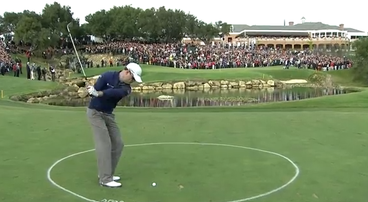 That last stat fitted perfectly for Zac after hitting his second into the hazard guarding the green. The designated drop zone allowed him to drop his ball to his preferred approach wedge distance and the rest is history. Plus he hit his shot inside his average proximity to hole by 10'7" exactly! With the above statistics Zac will continue to make cuts, win golf tournaments and keep making his family, sponsors and bank manager very happy. David Milne and Lawrie Montague - Pro Tour Golf College Your Success On Tour is Our Business "Each day of training, you realize more and more that this game is not easy, it's a grind, but if you wanna be successful you gotta learn to live it and love it!" 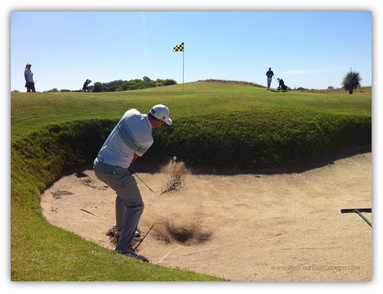 My name is Bradley Johnson, and I'm a PGA golf professional who decided to make a directional change and open my mind to what can be! I have been playing the game of golf seriously for the past 11 years as firstly an amateur and then decided to get my PGA accreditation by doing a PGA traineeship in Brisbane, Australia. Since playing competitively for prize money as a pro, I have had my ups and downs, and I walked away from the game for a while and went and caddied on the Web.Com tour for a year. I came back this year in July and gave myself some serious goals for 2013/14 of gaining a better ranking here in Australia, through traveling to tour school in Melbourne and also trying to get status in South Africa by traveling to the sunshine tour school in January 2014. I started practicing just as I had done for the last 6 to 7 years, working out things on my own, and getting other pros to video me, and I would have a look every 3 to 4 days if I was not competing. Then I would spend 18 to 20 hours a week 'practicing' on my own. This would consist of 10 hours of short game and wedge work, and 10 hours of long game work. It was just the same way as if I operated like a computer, on the same loop week after week! 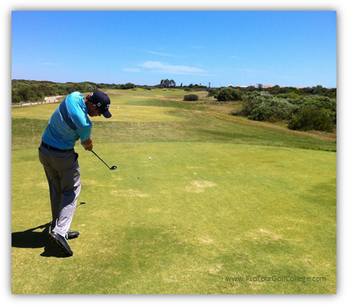 I felt like I could compete with it or at-least that's what I told myself. Most of my pro-am results were less than stellar and having a high score average of somewhere in region of 80 was not good for a professional. I really started to get frustrated as I knew there was a game there but the lack of consistency both with concentration and the ability to isolate one shot was lacking. It was not only that, more the sense of panic that was starting to build that I would have to change something in order to feel solid before Q school. We always bounce ideas off each other as pros and after having a good chat to two students who have and are attending Pro Tour Golf College they suggested I look into it. I had an in-depth peruse through the website and further chats with the boys and in the end decided to contact David and Lawrie to see what we could do together! 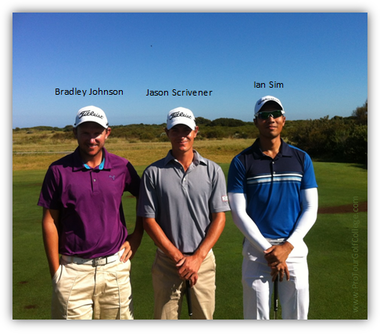 I decided that giving myself a semester in the tour golfer program as I thought that it would be a great start to change my practice regimes, my work ethic, my mental skills and anything else that I could soak up. The program and the structure from day one has been nothing but empowering for my golf career. We started with 'hell week' in week one, working on all aspects of my game, getting stats and percentages from putting, short game, long game, sand and trouble shots, the lot! It was brand a new experience for me, the structure from day one was very precise and calculated and covered every area of your game. "I came to Pro Tour Golf College with a three month goal of getting a tour card, and I will leave this semester knowing I will play this game regardless of whether I achieve that goal now or three years from now." 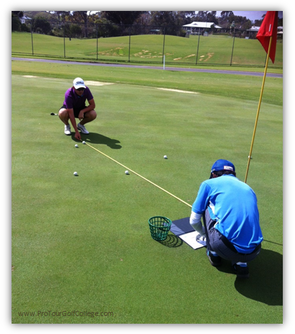 It helps you to see your strengths and weaknesses across the board and where the immediate improvements are needed. Each week you have the knowledge of two seasoned professionals who have experienced all aspects of the game. Coaching, playing, forever learning and staying one step ahead of the curve. This program is for the serious amateur that wants to succeed and become a pro tour player. My short game and bunker player after structured practice and being dedicated to putting in the hard work and hours is starting to pay off immensely. That's just the start of my journey to being a consistent golf professional that can compete on a larger stage, and I want to earn the privilege of being under pressure. 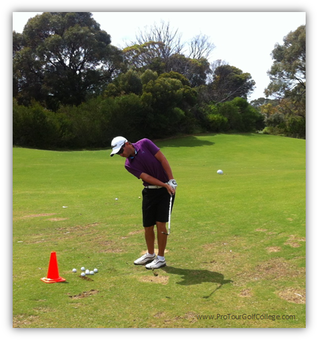 I thought I had played 'professional golf' for the last 3 years, but I have not played PROFESSIONAL golf until now. The mental training in Pro Tour Golf College is not delivered by psychologists, and you are not writing down your feelings etc. It's done out on the practice green, on the range and every minute of every practice session. I didn't know how to isolate one shot, have a 5 second rule to accept the shot and move on. The picture has become a lot clearer after a semester with Lawrie and David. Each day of training, you realise more and more that this game is not easy, it's a grind, but if you wanna be successful you gotta learn to live it and love it! I came to Pro Tour Golf College with a three month goal of getting a tour card, and I will leave this semester knowing I will play this game regardless of whether I achieve that goal now or three years from now. They changed my timeline plain and simple! 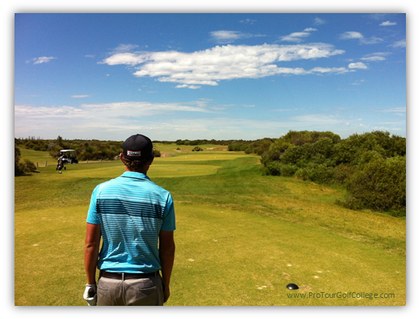 Visualizing the golf shot is one of the hardest things to do when you don't have confidence. I have learned that confidence stems from competence, you have to train your mind to see the shot, but first you have to have the tools to execute! Pro Tour Golf College has given me the tools that I will use for the rest of my career. If you feel you cannot play a shot, these guys have every shot in the book! Simple effective, small adjustments will show you that you have the capability, just no one has shown you in the past how to play it effectively with competence. It mentally gives you a charge when you hit a good one with a slight change and you want to build it so you work and work to build the competency platform! The 10,000 hours rule does apply to golf, that's dedication to your craft, that's 10,000 real hours. PTGC is a place where there are no real swing re builds; it’s about manageable adjustments that allow you to move forward and progress to that next level of competency. You see results through structure and hard work! I am still on my own journey to becoming a more balanced player with better practice methods and better mental loops. If you are serious about learning skills and structure that WILL increase your ability to score, I could not endorse any other program that I have participated in! All summed up confidence for me has started to build competence and I know that in months and years to come I will develop consistency because I will stick to the skills these pros have given to me. Bradley Marcus Johnson - PGA (Aust) 
Email us today at [email protected] for more information
"The one way to make sure this does not happen to your child is to take notice of what the research has found and recommends. It suggests that children under the age of 13 years old should be encouraged to play three different sports, and this ideally would be cut down to two sports by 15 years of age and to specialize at around the age of 16 to 17 years old". 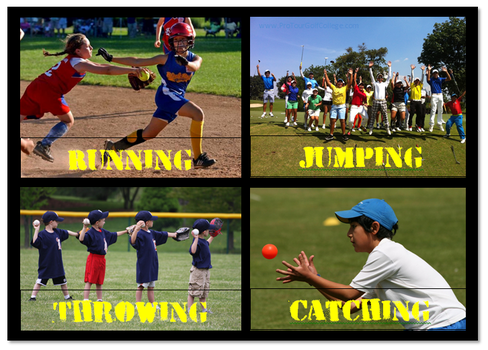 Does your son or daughter have the 'ing' in their golf background? Does your son or daughter have the 'ing' in their golf background? The biggest mistake a parent of a junior golfer can make is to allow their child to specialize in golf at a very young age. I use the word "allow" because many of these parents are being guided by golf instructors who don't have a full understanding of the long term junior pathway required to develop the fundamental athletic abilities in tandem with learning how to play golf. The Golf-ing Abilities There are four fundamental athletic abilities (we call them 'ing' abilities as in runn-ing...) that all young juniors must learn and be exposed to, which in turn will be helpful in taking their golf game to the highest level possible. The four abilities are;
They are all equally important but the two that most juniors especially in South East Asia don't normally learn to any degree is catching and throwing. Because the main sport watched and played in many South East Asian countries is football (soccer), the two skills of catching and throwing are not required, so junior golfers who specialize and / or only play football don't fully develop those important abilities. It's my experience (41 years as a golf professional) working with junior golfers, when these two fundamental athletic abilities are not fully developed, touch and feel are the "victims". 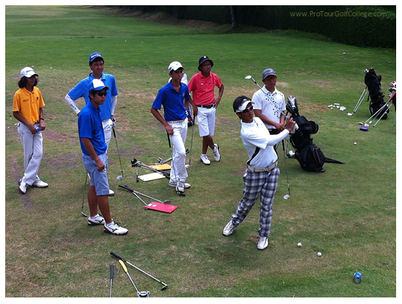 These junior golfers have played other sports and now excel at golf These junior golfers have played other sports and now excel at golf When touch and feel don't get developed to the highest level, pitching, chipping and putting will suffer, which translates to the scores of young golfers stagnating at around the age of 14 years to 16 years. This is dependent on whether male or female, and females tend to mature physically earlier then males. Many of these juniors because of their early specialization tend to dominate their age group in competition initially, but it is not too long before the other juniors (who have developed all the four skills running, jumping, catching, throwing) begin to catch up and go past them. The early junior golf specialists for the most part are not used to being second best and for many, they give the game away completely. The one way to make sure this does not happen to your child is to take notice of what the research has found and recommends. It suggests that children under the age of 13 years old should be encouraged to play three different sports, and this ideally would be cut down to two sports by 15 years of age and to specialize at around the age of 16 to 17 years old. Allow and encourage your child to play other sports especially team sports that will develop all the above four fundamental athletic abilities which in turn will enhance their coordination and core body strength at the same time. As many parents are concerned about their child playing contact sports I would recommend basketball, baseball, softball, cricket or badminton as these sports encourage all four fundamental abilities, plus there is the benefits of improving their fitness levels as well. 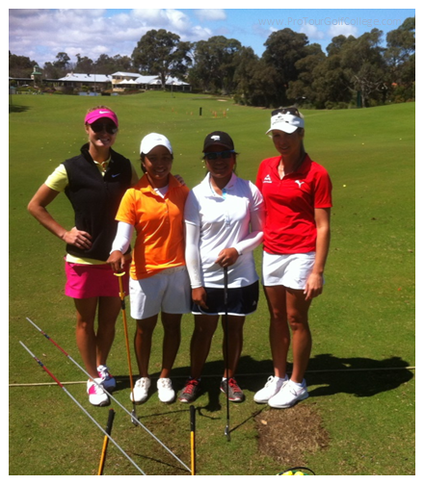 Tour golfers Carly Booth and Danielle Montgomery played other sports before golf Tour golfers Carly Booth and Danielle Montgomery played other sports before golf The sports your child plays need to include the skills listed below to help them become well rounded athletes which will enhance their golf specific skills. One leads to the other although there are always exceptions to the rules, so follow the guidelines below. These guidelines will give your child or the junior you're coaching the best chance to become the best they can be plus keep them playing the game past their junior days.
Lawrie and I have a firm commitment to helping junior golfers to reach their potential and to also provide information to parents and coaches that is backed not only by years of experience coaching juniors to top level but also solid, relevant and practical research that will help you take your son, daughter or students golf game to the next level and beyond. Pro Tour Golf College - Indonesia Launches in 2014 In 2014 we launch our Pro Tour Golf College Junior Development Program in Jakarta, Indonesia aimed at taking junior golfers from South East Asia to the pro tour (see advert below). We are presently developing a state of the art golf training centre which will have amongst other things the best short-game training facility in South East Asia. So if you are looking for a full-time and part-time world class junior development program for your son or daughter in 2014 that will develop the whole golfer then please feel free to contact us for more information at [email protected] You can contact us for more information on junior development advice, and please like and share our articles if you enjoy reading them and feel that they benefit you and your friends. David Milne and Lawrie Montague - Pro Tour Golf College Your Success On Tour is Our Business “No conscious effort whatsoever went into that putt. There were no thoughts about ‘this is for the open’…I stroked it in”. – Sergio Garcia 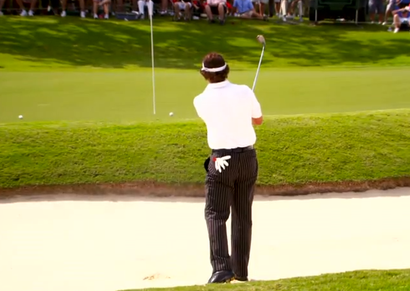 Thinking and Skill Execution- Part II Part one of this two-part blog introduced the idea of flow and the first step toward achieving flow in your game. The aim of this blog is to provide an insight into the second step, how thoughts might be translated into skilled action and ultimately flow. The ability to consistently engage in ‘System 1’ thinking (fast and automatic) is difficult to achieve and requires effort during practice. Players know that by training the body to effectively execute a skill they should become better at doing so. The same principle is applied to the mind. Implementing effective ‘brain training’ strategies allows players to develop their mind ready for the demands of competition. The following focus areas and example drill can help train the brain to engage in ‘System 1’ thinking. 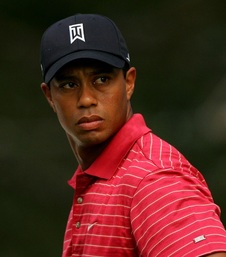 FOCUS To begin you require a clear focus on…
Avoid thoughts on technique, previous shots or ideal outcomes.
Releasing yourself from trying to control your technique or path.
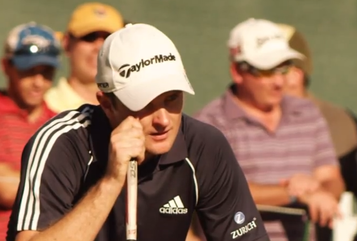 ASSESSMENT To assess how well you engage in ‘System 1’ thinking, ask yourself these 7 questions:
Training your brain to engage in ‘System 1’ thinking is best practiced in putting drills and then you can work your way up to applying it in your full game. Various Clubs Drill The various club drill involves creating a 6 foot (2 metre) putt using a variety of clubs (fairway wood. iron, driver, etc.). This drill aims to help you release yourself from a focus on technique and simply focus on creating the shot with your natural athleticism and instinct. Flow is achieved in ‘System 1’ thinking- Implementing drills such as this into your training schedule can help train your mind toward a state of flow when the stakes are high. The more you implement drills such as these, the more your mind adjusts. You should find that as you continue to practice these focus states, they will become instinctive to your game and your natural and developed physical abilities will occur without engaging in ‘System 2’ thinking. This information can be a useful starting point toward achieving flow in your game. An appointment with a MNC psychologist can introduce more drills to engage ‘System 1’ thinking and work with you to refine thought control strategies and implement skills most suited to you. 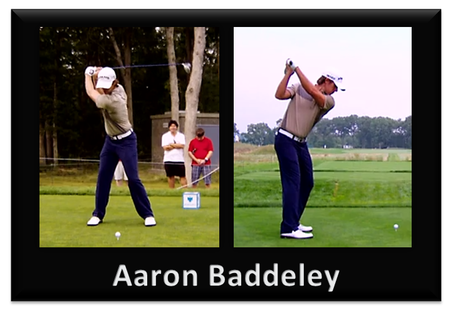 It's been thirteen years since a twenty year old Aaron Baddeley with two Australian Opens already under his belt declared that he was aiming to be number one in the World Golf Ranking in the near future! Fast forward to November 2013 and Aaron has won three times on the PGA Tour (2006 Verizon Heritage, 2007 FBR Open, 2011 Northern Trust Open) and four times on the Australasian Tour. He has accumulated US $16,334,735 over his career and for most journey man professionals this would be viewed as an impressive career up to this point. But for someone who still has ambitions to be number one it has not gone to plan. Aaron turned professional in 2000 the same year as Adam Scott and he headed off to the PGA Tour with invites to play in nine events including the Masters. Unfortunately he made only 1 cut. In 2001 it wasn't much better where he played in nine events and made just 2 cuts and a paltry US$19,435.00. Although missing out at tour school at the end off 2001 he managed to gain playing privileges on the then Nationwide Tour. So for someone who had expected to be playing with the big boys on the PGA Tour and beating them he had to earn his place in the "Big Show". This he did at the end of 2002 by finishing in the top five a total of 5 times on the Nationwide Tour, with a total of US $216,536.00 and a full card to play on the 2003 PGA Tour. Aaron has kept his card since then but it has not been plain sailing managing to just keep his card a few times by finishing inside the 125 number on the money earned list. So for a young golfer of nineteen years old who had won two Australian Open's behind him what has sabotaged his goal of winning more tournaments, a major championship and moving into the top ten in the World Golf Rankings?. Without a doubt his driving accuracy has held him back to some extent hitting on average 56.02% of fairways with an average ranking of 183.18 over the twelve years he has been on the PGA Tour. Combine this with his greens-in-regulation average of 61.00% and an average ranking of 172.25, the question begs to be asked how is he keeping his card, never mind wanting to be the number one ranked player in the world! 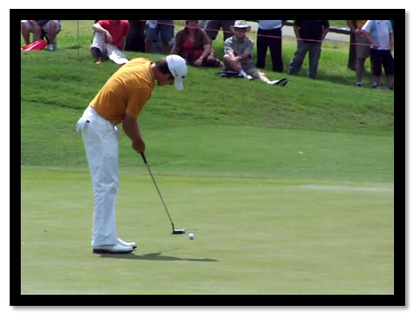 Well it's no secret that Aaron has been one of the top putters on tour every year and his average ranking (10.08) since they have kept Strokes Gained-Putting stats since 2004 is indeed very impressive. So for a handful of events each year, when his ball striking improves marginally, he gets himself into contention and earns a big paycheck. When his driving accuracy and greens in regulation improve to over 60% like they did in 2007 his annual earnings tripled to US $3,446,119.00 and he led the US Open at Oakmont golf club after three rounds. Now the simple solution would be to improve his full swing technique and "presto" he's on his way to achieving his golfing goals. Well Aaron's way ahead of that solution. His coach in his junior and early professional career was leading Australian coach Dale Lynch who did a incredible job of coaching and preparing the young Aaron Baddeley to win the Australian Open in 1998 as an 18 year old amateur (the 1st amateur since Bruce Devlin's win in 1960). And if that wasn't amazing enough, he then backed it up in 1999 to win again! Unfortunately (as is often the case) Dale took the blame when the young Aussie sensation didn't make the expected transition to the top level of golf after turning professional, and eventually David Leadbetter was engaged to take the reins as his coach for a few years. As the stats below show will show, his stats did not change. 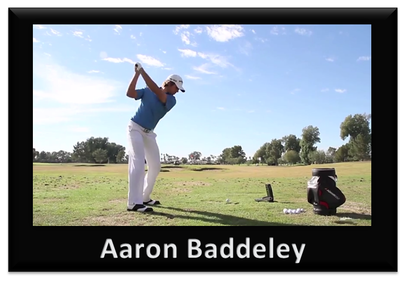 So in 2006 he made the (some would say) radical switch to the "Stack and Tilt" coaching method with Andy Plummer and Mike Bennett, and you will note that his driving accuracy did move above 60% for the 1st time. But as it happens many times with some tour players Aaron decided to make the move back to Dale Lynch at the end of 2008, and although his greens in regulation did improve, his driving accuracy again started to slide backwards to where it was barely above 50% at the end of 2013. Well of recent times he's made yet another move and is now working with former PGA Tour player Grant Waite and teaching professional Joseph Mayo, who use the Trackman system (which measures statistical data of golf shots), and a proprietary golf science method to give them the sort of detailed analytics that they believe will help Aaron to make progress towards his major goal. Aaron has made a good start to the overlapping 2014 PGA Tour season which is underway, and a top five finish at the CIMB Classic in Kuala Lumpur (yes the PGA Tour is in Asia as well) has put him in 29th spot on the 2014 money list with nearly US $300,000.00. Only time will tell if he has finally made the right move, but in our opinion unless his driving accuracy and greens in regulation performances improve he will not get even close to achieving the world number 1 ranking he declared he was aiming for in 2000. We think (in our humble opinion) that it's somewhat ironic (when you read the quote below) that Aaron would want to change coaches once again to another method of instruction especially when he was being coached to simply play free and easy and have fun much like he did when he was a kid with the golfing world at his feet. "It sounds weird, but he (Dale Lynch) had such an impact on my golfing career growing up," Baddeley said. "He was very much like a mentor, the way I thought, the way I practiced, the way I went about everything. To be able to come home -- come back to Dale -- felt like coming home because it felt like I was becoming a kid again. And that's what made it fun." - Aaron after winning The Northern Trust Open in 2011 at Riviera Country Club. Lawrie and I will keep you up to date in the new year with how Aaron Baddeley fares on the PGA Tour under the guidance of his new instruction team.
Whichever way it goes we wish him all the very best in the years to come. David Milne and Lawrie Montague - Pro Tour Golf College Your Success On Tour is Our Business |
Archives
June 2019
|
Proudly Supported By
Copyright © 2011 - 2018 Pro Tour Golf College
Website Managed By Golf Performance Media
All Rights Reserved
Website Managed By Golf Performance Media
All Rights Reserved


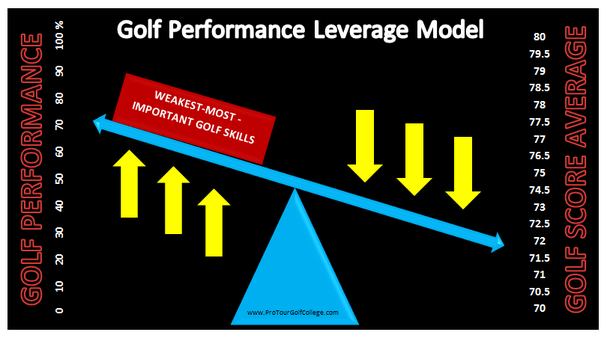
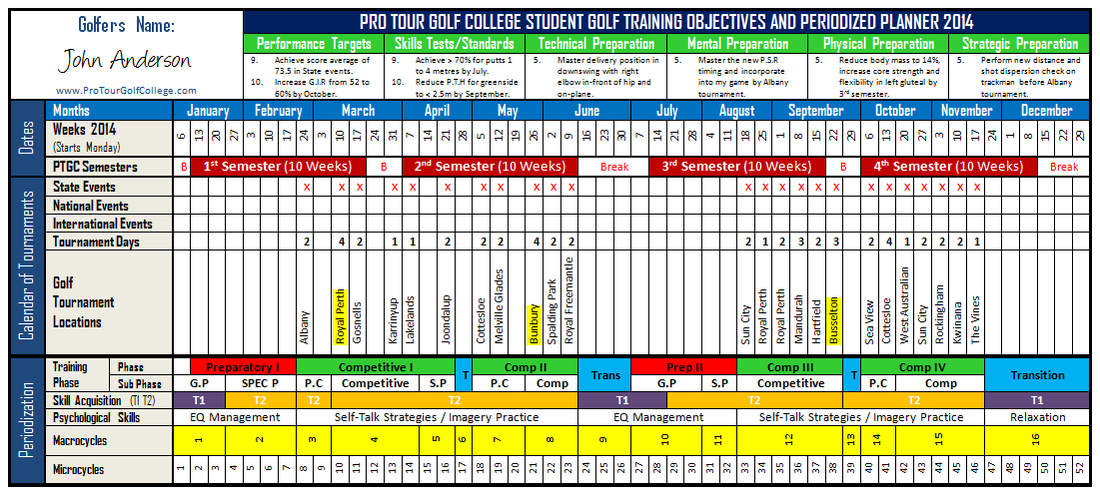

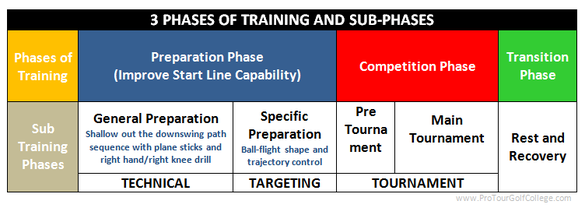
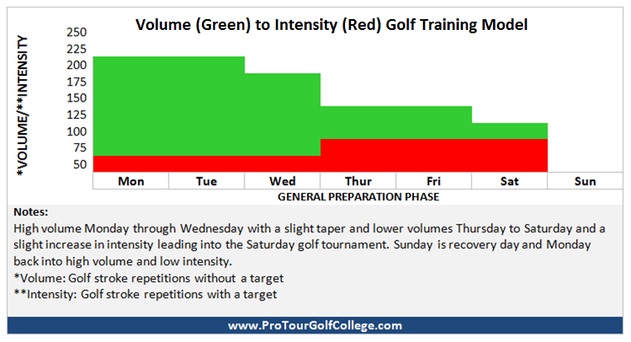
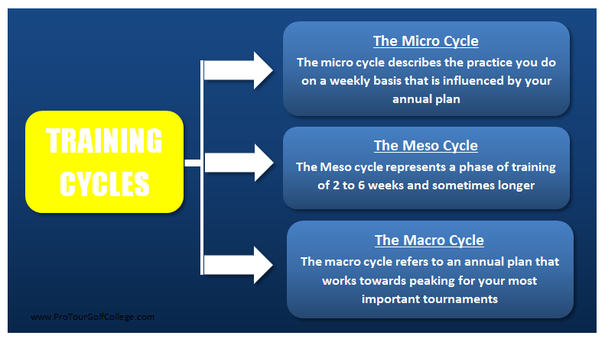


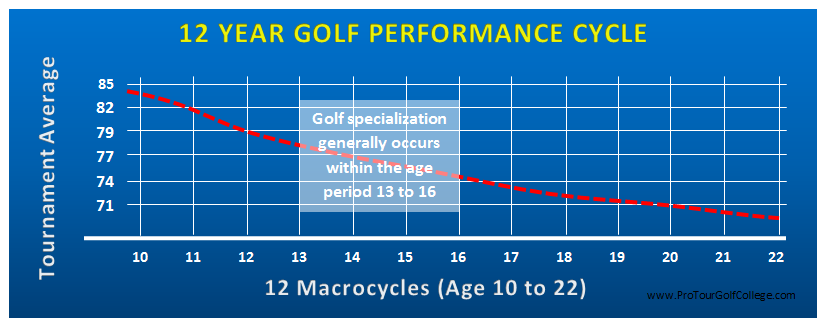
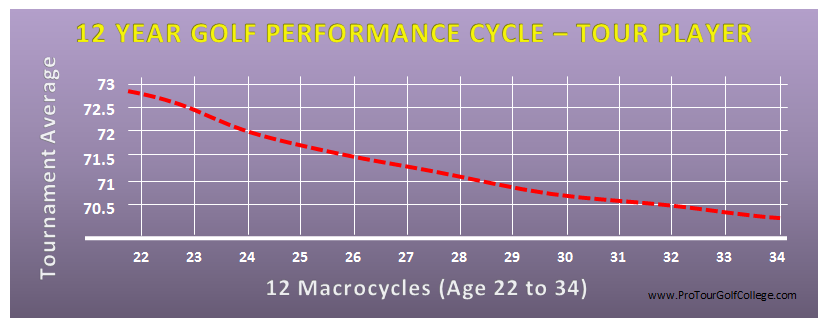


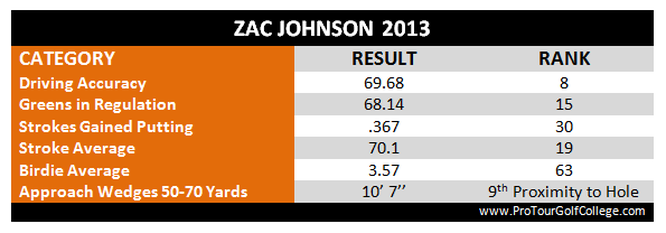

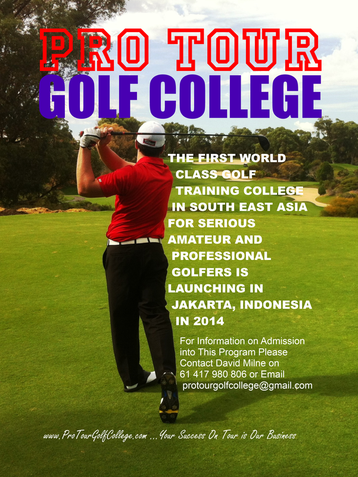

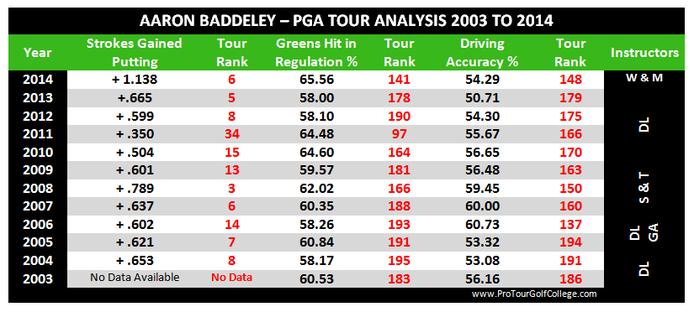
 RSS Feed
RSS Feed



